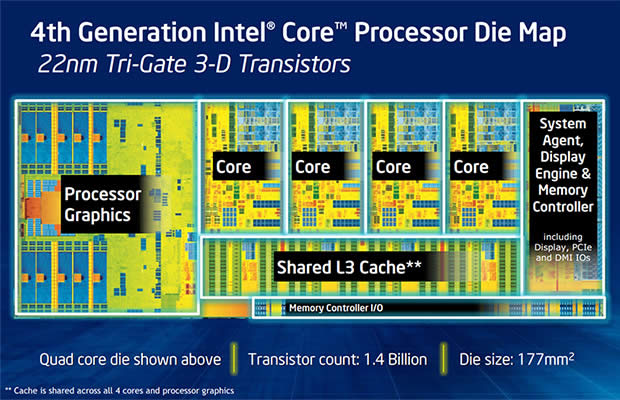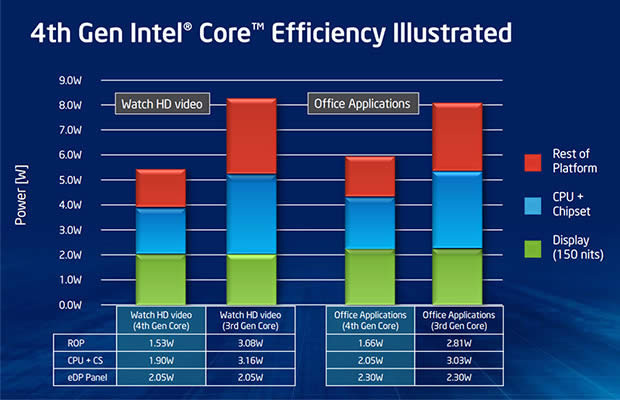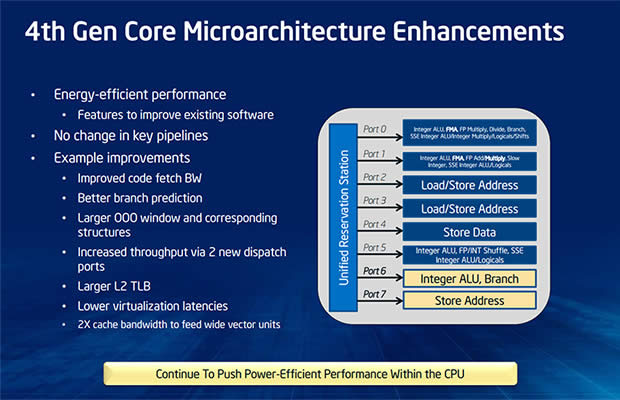Our Aim
To provide you with an overview on New And existing technologies, hopefully helping you understand the changes in the technology. Together with the overviews we hope to bring topical issues to light from a series of independent reviewers saving you the time And hassle of fact finding over the web.
We will over time provide you with quality content which you can browse and subscribe to at your leisure.
TekSpek 's

Intel Haswell
Date issued:
4th Generation Intel Core Processor Family
With PC and mobile converging quicker than ever before, Intel needs to reassert its presence in portable devices with an architecture that can scale across multiple platforms. That quest begins with the introduction of the fourth-generation Core processor family, codenamed Haswell.
Launched as a successor to last year's Ivy Bridge, Haswell follows Intel's tick-tock release schedu le, where a tick (Penryn 2008, Westmere 2010, Ivy Bridge 2012) primarily insinuates a shrink in manufacturing process, and a tock (Nehalem 2009, Sandy Bridge 2011, Haswell 2013) implies a major architectural refresh.

Yet, from a manufacturing point of view, not a whole lot appears to have changed. Looking at an overview of a quad-core desktop Haswell die, the chip is very similar to incumbent Ivy Bridge; it's built using the same 22nm Tri-Gate process and continues to carry 1.4 billion transistors, albeit in a slightly larger 177m² die (up from 160mm²).
Optimising Power
Intel has taken a multifaceted approach to enhancing efficiency in Haswell as both a processor and a platform. At a silicon level, the company has introduced fine-grained control over which parts of the die are turned on or off. As we know, existing Ivy Bridge processors - that feature up to four IA cores, a graphics processor and a memory controller all hooked up to a ring-based interconnect - allow for the CPU and GPU to go idle, but other components remain active.
With Haswell, the philosophy is that if you don't need it, it ought to be turned off. In order to make this happen, Intel has added more power gating and decoupled the ring-based interconnect and L3 cache from the IA cores, allowing, for example, the GPU access to the ring bus without waking the IA cores. Expanding on this granularity, ultra-low-power Haswell mobile processors will be equipped with deeper C-States (C8, C9, C10) that allow practically everything to be turned off when idle. In addition, fourth-generation processors are said to switch between states 25 per cent faster than their third-generation predecessors.

Taking into account connected systems as a whole, Intel has also created a more suitable middle ground between the ACPI specification's S3/S4 sleep and S0 active states by introducing new active-idle states dubbed S0i1 and S0i3. With previous-generation platforms, putting a computer to sleep and waking back up was achievable in just a couple of seconds, but the experience wasn't as quick as, say, on a smartphone or tablet.
Learning from those platforms, and already available in certain Intel Atom processors, the low-power S0ix active idle states are designed to deliver power savings similar to that of S3 sleep, with the added incentive of being able to return to S0 active almost instantaneously (we're talking a matter of milliseconds). This low-power 'connected standby' state is said to be 20 times more efficient than the previous generation, and with the Haswell platform designed to run in this mode the majority of the time, the power savings should add up.
The goal is to make mobile PCs function in a manner similar to smartphones and tablets. Mobile Haswell devices will remain connected to the web in an ultra-low-power state at all times, allowing the PC to stay up-to-date and wake instantly.
Architecture Improvements
Haswell's primary ambition may be to drive down power consumption, but it wouldn't be a new Intel architecture without performance improvements on both the CPU and GPU fronts.
One of Haswell's most striking enhancements is that the number of back-end execution ports has been upgraded from six to eight. This is the first increase in execution ports we've seen since Conroe, and the new additions give Haswell a fourth port for math logic and a fourth for store address calculations.

Ensuring that the wider back-end is well fed, Intel has also made further branch prediction improvements to ensure fewer cache misses. As you might expect, faster buffers and faster access to level one memory are also a priority. Each Haswell core continues to be served exclusively by a 64KB L1 cache and a 256KB L2 cache, with a third last-level cache of up to 8MB shared across all cores, the graphics processor and system agent.
This time around, L1 store bandwidth is doubled from 16 bytes/cycle to 32 bytes/cycle, and interface bandwidth between the L1 and L2 caches has doubled from 32 bytes/cycle to 64 bytes/cycle. Although Haswell is officially described as new micro-architecture, it's clear that it has a lot in common with earlier generations and the focus has been on getting the most out of a tried-and-trusted system.
Iris Graphics
Intel has made progress with its integrated graphics processor in recent years, yet there's no escaping the fact that the company's HD Graphics have lagged behind the competition. The best Ivy Bridge option - HD 4000 - pales in comparison to rival AMD parts, and of course can't hold a candle to even low-end discrete graphics solutions.
With today's devices becoming increasingly media-centric, Intel needs to shake-off its image as a sub-par graphics provider and become, at the very least, competitive. So what can Intel create to compete with AMD's Radeon and Nvidia's GeForce? The answer is Iris.

In order of performance, Haswell's IGP will be available in at least half-a-dozen models; Iris Pro 5200; Iris 5100; HD 5000; HD 4600; HD 4400 and HD 4200. The reason for this is that, unlike Ivy Bridge's HD 4000 IGP, the graphics in Haswell have been deliberately designed to be scalable. The amount of scalability is reflected in the number of execution units, in what Intel calls a slice, and the operating frequency of each core will be dependant upon processor positioning.
The top-of-the-range Iris Pro 5200 is said to have 40 execution units, while the middle-of-the-pack HD 4600 is believed to have 20. This compares to 16 such units in the best Ivy Bridge chips, but remember, the execution units themselves have been overhauled for Haswell and can't be compared directly.
Making matters even more interesting, and illustrating Intel's need to push graphics performance, certain Haswell IGPs will be paired with a dedicated eDRAM frame buffer that will be accessible to both the CPU and GPU, and will further benefit performance in either workload.
4th Gen Range
Haswell Core Processor Family (4th Generation, LGA1150) |
||||||||||
|---|---|---|---|---|---|---|---|---|---|---|
Model |
Cores / Threads |
CPU Clock (GHz) |
Turbo Boost (GHz) |
Process |
Die Size |
Cache |
IGP |
IGP Clock (MHz) |
DDR3 Support (MHz) |
TDP |
| Core i7-4770K | 4 / 8 |
3.5 |
3.9 |
22nm |
177mm² |
8MB |
HD 4600 |
1,250 |
Dual 1,600 |
84W |
| Core i7-4770 | 4 / 8 |
3.4 |
3.9 |
22nm |
177mm² |
8MB |
HD 4600 |
1,200 |
Dual 1,600 |
84W |
| Core i7-4770S | 4 / 8 |
3.1 |
3.9 |
22nm |
177mm² |
8MB |
HD 4600 |
1,200 |
Dual 1,600 |
65W |
| Core i7-4770T | 4 / 8 |
2.5 |
3.7 |
22nm |
177mm² |
8MB |
HD 4600 |
1,200 |
Dual 1,600 |
45W |
| Core i7-4765T | 4 / 8 |
2.0 |
3.0 |
22nm |
177mm² |
8MB |
HD 4600 |
1,200 |
Dual 1,600 |
35W |
| Core i5-4670K | 4 / 4 |
3.4 |
3.8 |
22nm |
177mm² |
6MB |
HD 4600 |
1,200 |
Dual 1,600 |
84W |
| Core i5-4670 | 4 / 4 |
3.4 |
3.8 |
22nm |
177mm² |
6MB |
HD 4600 |
1,200 |
Dual 1,600 |
84W |
| Core i5-4670S | 4 / 4 |
3.1 |
3.8 |
22nm |
177mm² |
6MB |
HD 4600 |
1,200 |
Dual 1,600 |
65W |
| Core i5-4670T | 4 / 4 |
2.3 |
3.3 |
22nm |
177mm² |
6MB |
HD 4600 |
1,200 |
Dual 1,600 |
45W |
| Core i5-4570 | 4 / 4 |
3.2 |
3.6 |
22nm |
177mm² |
6MB |
HD 4600 |
1,150 |
Dual 1,600 |
84W |
| Core i5-4570S | 4 / 4 |
2.9 |
3.6 |
22nm |
177mm² |
6MB |
HD 4600 |
1,150 |
Dual 1,600 |
65W |
| Core i5-4570T | 2 / 4 |
2.9 |
3.6 |
22nm |
177mm² |
4MB |
HD 4600 |
1,150 |
Dual 1,600 |
35W |
On the desktop side of things, Intel is racing out of the gate with a dozen solutions ranging from the 35W Core i5-4570T to the top-of-the-line 84W Core i7-4770K.
The fact that each and every launch-day desktop Haswell processor is equipped with a HD 4600 IGP suggests that Intel believes consumers will want to pair the processors with a dedicated graphics card. However, distinguishing between features - which chips are multiplier unlocked, which are low-power, etc. - remains a complex task. In an effort to simplify matters, Intel has five suffixes that it uses to illustrate certain variables:
Desktop Haswell Processor Suffixes
- No suffix - standard processor aimed at the mainstream
- K - multiplier unlocked, providing greater overclocking potential for enthusiast users
- P - no integrated graphics processor
- R - high performance Intel Iris graphics, BGA package
- S - "performance optimised lifestyle," features a lower CPU base frequency and a reduced TDP
- T - "power optimised lifestyle," features a lower CPU base frequency, a lower Turbo Boost frequency and a greatly-reduced TDP
New Chipsets
All of the architectural advancements in Haswell have resulted in the need for a new LGA1150 socket and, therefore, a new supporting 8-series chipset headlined by the Z87. The new chipset natively supports more high-speed USB and SATA interfaces, and it is designed to be physically smaller, making it easier for motherboard manufacturers to create Z87 solutions that are more compact, less-cluttered and more efficient.
Overclocking
To satiate the needs of overclockers, Intel has borrowed from the X79 platform and reintroduced base clock ratios. What this means is that, like Sandy Bridge Extreme, Haswell processors will run at a choice of three base clocks: 100MHz, 125MHz and 166MHz, with a bit of extra wiggle room thrown in. This means that you should be able to overclock every Haswell chip - even a mid-range Core i5-4570 might run at 4GHz, provided it's stable when the default 32x multiplier is partnered to a 125MHz base clock.
Of course, the premium multiplier-unlocked parts offer extra incentive. Intel allows an 80x multiplier at 100MHz, up to 64x at 125MHz and up to 48x at 166MHz. There are various ways of getting to 8GHz, but while neither Sandy Bridge nor Ivy Bridge offered such flexibility, remember that, as always, your overclocking mileage will vary.
Summary
An examination of the Haswell architecture suggests that fourth-generation processors will be up to 20 per cent faster than the previous generation in CPU-intensive tasks, and up to 50 per cent faster in IGP-intensive tasks, when evaluated over a wide range of benchmarks. A more efficient architecture and a revamped integrated graphics processor are the primary instigators for this performance increase.
Yet, while performance is up, Haswell's greatest strength lies in the energy-saving department. Intel's latest chips, designed for a new breed of ultra-thin, ultra-efficient PCs, are without doubt the most advanced to date, and will scale across a wide range of devices ranging from tablets to servers.
As always, Scan Computers will have a complete range of new chips and supporting motherboards available at competitive prices.